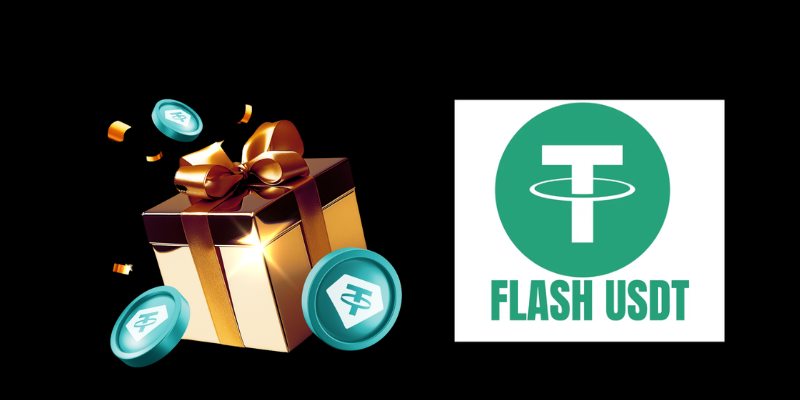What is Flash USDT? At its core, Flash USDT refers to a mechanism that mimics Tether (USDT) transactions, creating temporary or artificial balances in crypto wallets to simulate liquidity or facilitate rapid transactions. Often marketed as a tool for trading, staking, or peer-to-peer (P2P) transfers, Flash USDT has gained notoriety due to its association with scams and fraudulent schemes. This article explores what is Flash USDT, its purported applications, and the critical risks investors and users must navigate, drawing parallels with speculative token launches like $TIME on Raydium LaunchLab.
Understanding Flash USDT: Mechanics and Claims
What is Flash USDT? Flash USDT, sometimes labeled as “Fake USDT,” is a digital construct designed to emulate legitimate Tether (USDT) transactions on blockchain networks like TRC20, ERC20, or BEP20. Unlike authentic USDT, which is a stablecoin pegged to the U.S. dollar and backed by reserves, Flash USDT is temporary and lacks intrinsic value.
It is generated using specialized software that manipulates wallet balances to display USDT-like funds, which can appear tradable, transferable, or swappable for a limited duration—often claimed to last 38 to 90 days or more. These transactions are verified on blockchain explorers, creating an illusion of legitimacy.

Proponents of Flash USDT market it as a tool for high-speed transactions, flash loans, or arbitrage opportunities. For instance, platforms like flashtransaction.com advertise Flash USDT for trading, staking, or P2P transfers, claiming compatibility with wallets like Binance and Trust Wallet. The appeal lies in its ability to provide instant liquidity without traditional delays, a feature that resonates with the fast-paced Solana ecosystem, where tokens like $TIME on Raydium LaunchLab thrive on rapid market momentum.
However, the artificial nature of Flash USDT raises significant ethical and legal questions, as its primary use often involves misleading counterparties or exchanges.
Flash USDT in Practice: Use Cases and Platforms
To fully grasp what is Flash USDT, it’s essential to examine its purported applications. Flash USDT is often linked to flash loans, a DeFi mechanism allowing users to borrow funds without collateral, provided the loan is repaid within the same transaction block. In this context, Flash USDT could facilitate rapid arbitrage or trading strategies, leveraging USDT’s stability to exploit price discrepancies across exchanges. Platforms like usdtflashsoftwares.com promote Flash USDT for “temporary balance increases,” targeting traders seeking to demonstrate liquidity or execute high-volume transactions.
The $TIME token launch on Raydium LaunchLab, which occurred on April 15, 2025, offers a relevant comparison. $TIME, a meme coin on Solana, capitalized on community hype and Raydium’s AMM integration to achieve $1.454 million in trading volume within 24 hours. Similarly, Flash USDT relies on the allure of quick gains and seamless transactions to attract users. However, unlike $TIME, which operates within a verifiable blockchain framework, Flash USDT’s temporary balances are not backed by real assets, making them inherently unstable and prone to misuse.
The Dark Side: Flash USDT Scams
A critical aspect of what is Flash USDT is its association with scams. The Flash USDT scam, as exposed by outlets like BitcoinWorld, involves scammers generating fake USDT tokens or transactions to deceive victims into believing they’ve received funds. These schemes often use fake wallet balances or notifications to lure victims into sending real assets, such as Bitcoin, in exchange for nonexistent USDT. Once the payment is made, the scammer disappears, leaving the victim with worthless tokens. Such tactics exploit the irreversible nature of blockchain transactions, a vulnerability also highlighted in discussions about $TIME’s transparency on X.
Red flags include unexpected USDT deposits, requests for fees to “unlock” funds, or unverifiable transactions. Social media platforms like Reddit reveal user experiences with Flash USDT scams, with some seeking “genuine” Flash USDT software while others warn of fraudulent providers. The speculative frenzy surrounding $TIME, where accusations of “rug pulls” emerged, mirrors the distrust surrounding Flash USDT, underscoring the need for vigilance in emerging crypto markets.

Risks and Recommendations
What is Flash USDT if not a double-edged sword? While marketed as a tool for liquidity and speed, its temporary and artificial nature poses significant risks. Investors may face financial losses if they rely on Flash USDT for transactions, as its value can vanish after its expiration period. Regulatory scrutiny is another concern, as manipulating wallet balances could violate securities laws or anti-fraud regulations. The $TIME token’s launch, marred by transparency concerns, serves as a reminder that unverified projects require thorough due diligence.
To protect against Flash USDT scams, users should verify transactions on reputable blockchain explorers like Etherscan or Tronscan, avoid suspicious links or wallets, and never send payments to “unlock” funds. Engaging with established platforms like Raydium, which offers robust AMM integration, can provide safer alternatives for token trading. Investors considering speculative assets like $TIME should monitor official updates and community sentiment on X to gauge legitimacy.
Conclusion
What is Flash USDT? It is a controversial tool that promises instant liquidity but often serves as a vehicle for deception. While its applications in flash loans or arbitrage hold theoretical appeal, the prevalence of scams and ethical concerns overshadows its utility. The $TIME token on Raydium LaunchLab, despite its own challenges, operates within a transparent blockchain framework, offering a stark contrast to Flash USDT’s opaque mechanics. As the crypto market evolves, understanding what is Flash USDT empowers users to navigate its risks, prioritize verifiable investments, and approach speculative opportunities with caution.

